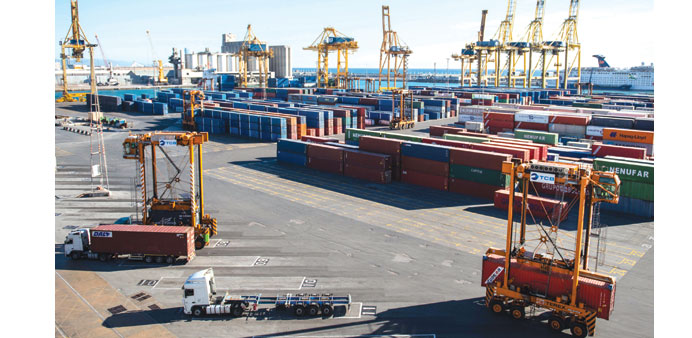Straddle carriers move shipping containers around the quayside at the commercial port in Barcelona. Government bonds in Europe’s most-indebted countries rallied in the first three weeks of the year on signs the debt crisis that pushed those nations’ borrowing costs to euro-era records had abated.
Bloomberg /Singapore
Bonds beat stocks last month for the first time since August as fixed-income securities worldwide enjoyed their best start to a year since 2008.
The start of the year in financial markets went as almost no one expected, with fixed-income assets worldwide posting their biggest January returns since 2008 and equity prices falling the most since 2010. Gold, given up for dead in 2013 as prices tumbled 28%, rallied.
“There’s no question that it has taken people by surprise,” Neil Azous, a founder of Stamford, Connecticut-based research firm Rareview Macro, which advises investors including hedge funds and money managers, said in a January 29 phone interview. “It’s painful.”
With the US Federal Reserve pledging to buy fewer bonds and the global economy gathering steam, the safe bet going into 2014 was to avoid debt markets in favour of equities. What few saw coming was the turmoil in emerging markets from China to Argentina that followed a slowdown in US jobs growth, upending even the best laid strategies of investors.
The Bank of America Merrill Lynch Global Broad Market Index returned 1.6% in January as of January 31, including reinvested interest, while the MSCI All-Country World Index of stocks lost 4.1%. The Standard & Poor’s GSCI Total Return Index of metals, fuels and farm products declined 1.6% even as gold jumped 3.2%, recovering from its biggest annual loss in 32 years. The Bloomberg Dollar Spot Index rose 1.2%.
The first shock came January 10, when the US Labor Department said payrolls rose by 74,000 in December, below the 197,000 median forecast of 90 economists surveyed by Bloomberg.
Almost two weeks later, a report from HSBC Holdings and Markit Economics said Chinese manufacturing may contract for the first time in six months. That added to concern growth in the Asian nation, which buys everything from Chile’s copper to South Korea’s cars, is losing momentum just as a high-yield trust in China threatened to default. HSBC and Markit confirmed this week that manufacturing in the nation shrank in January.
Then, Argentina’s peso started sliding as the central bank pared dollar sales to preserve international reserves that have fallen to a seven-year low. The central banks of India, Turkey and South Africa all raised interest rates to defend their currencies as they tumbled.
All of that followed the Fed’s December 18 decision to cut its purchases of Treasuries and mortgage securities to $75bn a month from $85bn, which did more to temper the appeal of high-risk assets than reduce demand for bonds. Policy makers said January 29 they will taper purchases to $65bn.
“This is an unusual January,” Joseph Quinlan, chief market strategist at US Trust Bank of America Private Wealth Management, which invests more than $300bn, said in a phone interview from New York. “We’re right on the knife’s edge where we’re coming off Fed tapering - a huge shift in monetary policy. Emerging markets have been suspect all along and there’s weakness in those markets. It’s all coming to a head.”
Benchmark US 10-year Treasury yields fell to 2.64% from 3.03% at the end of December, defying economists who predicted a rise to 3.4% by year-end, based on a Bloomberg survey of banks.
Some 62% of equity newsletter writers surveyed by Investors Intelligence were bullish at the start of January, the most in six years. The year-end forecast for the S&P 500 Index was 1,955, implying a 5.8% increase from December 31, according to 20 equity strategists surveyed by Bloomberg.
The rally in bonds worldwide followed last year’s 0.31% loss, the first since 1999, according to the Bank of America Merrill Lynch Global Broad Market Index.
The gauge, which tracks more than 21,200 securities with a market value exceeding $45tn, shows yields are about 1.9% on average, down from almost 2.10% at the end of December and last year’s high of 2.27% in September.
Gains were led by corporate debt, which returned 1.4% on average, including 0.5% for speculative-grade securities. Sovereign bonds added 1.5%, including 1.6% for US Treasuries.
Portugal’s bonds soared, gaining 6.6%, based on indexes by Bloomberg and the European Federation of Financial Analysts Societies. Spain followed, returning 2.8%. South Africa was the biggest loser, falling 2.8%.
Euro-area bonds extended their gains yesterday as a report showed inflation in the region slowed in January, boosting speculation the European Central Bank will need to take more measures to stimulate the economy. Spanish and Italian rates touched record lows and Germany’s 30-year yields fell to the least since August.
In a month dominated by gyrations in emerging-market currencies, the Bloomberg Dollar Spot Index jumped to 1,031.57, its highest monthly closing level since August.
The greenback benefited along with the yen from investors seeking a haven. Japan’s currency jumped 5.5% as measured by Bloomberg Correlation-Weighted Indexes, its biggest monthly gain since appreciating 8.5% in May 2012.
A Bloomberg customised gauge tracking 20 developing-nation currencies fell 3.1%. Argentina’s peso tumbled 19%, while South Africa’s rand plunged 5.7% and Russia’s ruoble dropped 6.5%.
“We know what the Fed is going to do, but we don’t know what the ultimate consequences are,” Robbert Van Batenburg, director of market strategy at Newedge Group in New York, said by phone. “We don’t know what’s going on in China with respect to the shadow banking system.”



